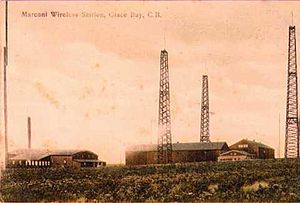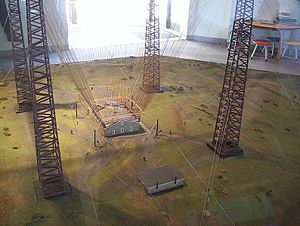Marconi and Marconi Wireless Station National Historic Sites facts for kids

An old postcard of the radio towers at the Marconi Wireless Station
|
|
| Location | In and near Glace Bay, Nova Scotia, Canada |
|---|---|
| Type | National Historic Site of Canada |
The Marconi National Historic Site and the Marconi Wireless Station National Historic Site are two special places in Canada. They are located on Cape Breton Island, Nova Scotia. These sites remember the amazing work of Guglielmo Marconi. He was a scientist who tried to send radio messages across the Atlantic Ocean. This happened in the early 1900s, connecting North America and Europe.
The two sites are about 8 kilometers apart. You can visit them by following the Marconi Trail. Another important place linked to Marconi's work is Signal Hill in St. John's, Newfoundland and Labrador. This site also celebrates Marconi's first radio tests in 1901.
Marconi National Historic Site
The Marconi National Historic Site is in Glace Bay, at a place called Table Head. This was the location of Guglielmo Marconi's very first radio station that could send messages across the Atlantic. Its special code name was VAS. On December 15, 1902, the first radio message from North America was sent to Europe from here!
Today, you can still see parts of Marconi's huge radio towers. There's also a modern amateur radio station. Plus, a museum tells the story of all the great things Marconi achieved.
Marconi picked this spot because it was high up and flat. It had a clear view of the Atlantic Ocean. You can still see the concrete bases where the giant towers once stood. In 1901, the first radio message from west to east crossed the Atlantic from this very spot to England. A special machine called a spark-gap transmitter used a lot of power (75 kilowatts). This power went to four tall antennas on the 2-hectare site overlooking the ocean. In December 1902, Marconi sent the first full messages to Poldhu in England from his stations in Glace Bay.
In 1905, Marconi's equipment was taken apart. It was moved to a bigger location southwest of here. That new place is now known as the Marconi Wireless Station National Historic Site.
The first Glace Bay site became a National Historic Site in 1939. It is now part of Canada's national park system. Parks Canada looks after it.
Marconi Wireless Station National Historic Site
Sending messages between Glace Bay and England was tricky at first. It often only worked after dark. So, Marconi built even bigger stations on both sides of the Atlantic. These were built between 1905 and 1907. One was in Clifden, Ireland. The other was a 350-hectare site just south of Glace Bay, near Port Morien. At the time, these two stations were the most powerful radio stations in the world!
The Marconi Wireless Station in Cape Breton stopped working in 1946. A local person named Russell Cunningham bought the land. His family still owns it today. All that is left of the station are the foundations of the tall antenna towers. There are also three old buildings that are in different states of repair.
This site became a National Historic Site in 1983. It is not part of the national park system. If you want to visit, you need to ask the owners for permission. A special sign from the government about this site is at the Old Town Hall & Glace Bay Heritage Museum. It is located at 14 McKeen Street in Glace Bay.


